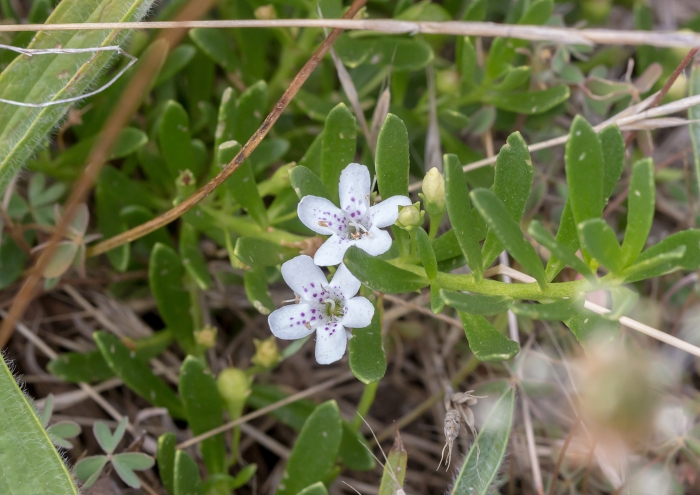Creeping Boobialla
(Myoporum parvifolium)
Creeping Boobialla (Myoporum parvifolium)
/
/

Andrew Allen
CC BY 4.0
Image By:
Andrew Allen
Recorded By:
Copyright:
CC BY 4.0
Copyright Notice:
Photo by: Andrew Allen | License Type: CC BY 4.0 | License URL: http://creativecommons.org/licenses/by/4.0/ | Rights Holder: Andrew Allen | Publisher: iNaturalist | Date Created: 2021-01-06T10:20Z |













Estimated Native Range
Summary
Myoporum parvifolium, commonly known as creeping boobialla, creeping myoporum, dwarf native myrtle, or small-leaved myoporum, is a perennial herbaceous plant native to coastal dunes and dry sclerophyll forests in southern Australia, including Flinders Island. It is a low-growing, spreading shrub reaching up to 6 inches (15 cm) in height with long, trailing stems that can extend several feet in width. The plant features small, ovate leaves and white, star-shaped flowers that bloom in spring and summer, adding a subtle charm to garden settings. The flowers are followed by purple, non-edible berries. Creeping boobialla is valued for its drought tolerance, making it an excellent ground cover for erosion control and for use in rockeries, coastal gardens, and as a filler between larger shrubs.
Creeping boobialla thrives in full sun to part shade and requires well-drained soil, tolerating a range of soil types from sandy to loamy. It is hardy and adaptable to most situations, including coastal conditions and poor soils, but it benefits from occasional watering during prolonged dry periods. This plant is typically propagated from cuttings and can serve as a rootstock for grafting more difficult-to-grow relatives such as Eremophila species. While generally disease-free, it can be susceptible to root rot in poorly drained soils. It is not known for aggressive roots or significant disease problems, making it a low-maintenance choice for gardeners.CC BY-SA 4.0
Creeping boobialla thrives in full sun to part shade and requires well-drained soil, tolerating a range of soil types from sandy to loamy. It is hardy and adaptable to most situations, including coastal conditions and poor soils, but it benefits from occasional watering during prolonged dry periods. This plant is typically propagated from cuttings and can serve as a rootstock for grafting more difficult-to-grow relatives such as Eremophila species. While generally disease-free, it can be susceptible to root rot in poorly drained soils. It is not known for aggressive roots or significant disease problems, making it a low-maintenance choice for gardeners.CC BY-SA 4.0
Plant Description
- Plant Type: Shrub
- Height: 0.3-0.5 feet
- Width: 0.48-0.8 feet
- Growth Rate: Rapid
- Flower Color: White, Pink
- Flowering Season: Spring, Summer
- Leaf Retention: Evergreen
Growth Requirements
- Sun: Full Sun, Part Shade
- Water: Low
- Drainage: Fast
Common Uses
Bee Garden, Butterfly Garden, Deer Resistant, Drought Tolerant, Fire Resistant, Groundcover, Low Maintenance, Salt Tolerant, Street Planting
Natural Habitat
Coastal dunes and dry sclerophyll forests
Other Names
Common Names: Slender Myoporum, Creeping Myoporum, Dwarf Native Myrtle, Small Leaved Myoporum
Scientific Names: , Myoporum parvifolium, Myoporum humile, Myoporum verrucosum, Pogonia aspera, Pogonia scabra, Pogonia tuberculata, Pogonia verrucosa,
GBIF Accepted Name: Myoporum parvifolium R.Br.